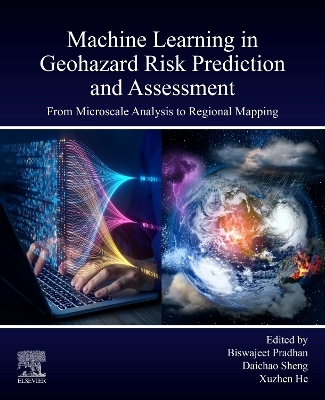
Machine Learning in Geohazard Risk Prediction and Assessment
Elsevier - Health Sciences Division (Verlag)
978-0-443-23663-1 (ISBN)
- Noch nicht erschienen (ca. November 2025)
- Versandkostenfrei innerhalb Deutschlands
- Auch auf Rechnung
- Verfügbarkeit in der Filiale vor Ort prüfen
- Artikel merken
Biswajeet Pradhan is a distinguished professor at UTS School of Civil and Environmental Engineering. He is an international expert in data-driven modelling and a pioneer in combining spatial modelling with statistical and machine learning models for natural hazard predictions including landslides. He has a track record of outstanding research outputs, with over 600 journal articles. He is a highly interdisciplinary researcher with publications across 12 areas, listed as having ‘Excellent’ international collaboration status. He has been a Highly Cited Researcher for five consecutive years (2016-2020) and ranks fifth in the field of Geological & Geoenvironmental Engineering. Daichao Sheng is a distinguished professor and the head of School of Civil and Environmental Engineering. He has developed an internationally recognized profile in computational geomechanics including soft computing, unsaturated soils, geo-risk analysis and transport geotechnics. He has published 300+ peer-reviewed papers and two books, including 200+ papers in top geotechnical and computational mechanics journals. These publications now attract 1400+ citations per annum, with an H-Index of 48 in Scopus. His track record places him easily within the top handful of geomechanics professionals of his age worldwide. He has collaborated widely with Australian and international researchers in his field Xuzhen He is a senior lecturer at UTS School of Civil and Environmental Engineering. He is an early career researcher and completed his undergraduate and PhD training at the world’s top universities (Tsinghua for his BSc and Cambridge for his PhD) and was awarded the John Winbolt Prize and the Raymond and Helen Kwok Scholarship from Cambridge University. He was awarded the Australian Research Council Discovery Early Career Researcher Award in 2021. His research interest lies mainly in computational geomechanics, and he has published 30+ high-quality journal papers in these areas.
Part 1: Machine learning methods and connections between different parts.
1. Machine learning methods
2. Connections between studies across different scales
3. Summary and outlook
Part 2: Machine learning in microscopic modelling of geo-materials.
4. Machine-learning-enabled discrete element method
5. Machine learning in micromechanics based virtual laboratory testing
6. Integrating X-ray CT and machine learning for better understanding of granular materials
7. Summary and outlook
Part 3: Machine learning in constitutive modelling of geo-materials.
8. Thermodynamics-driven deep neural network as constitutive equations
9. Deep active learning for constitutive modelling of granular materials
10. Summary and outlook
Part 4: Machine learning in design of geo-structures.
11. Deep learning for surrogate modelling for geotechnical risk analysis
12. Deep learning for geotechnical optimization of designs
13. Deep learning for time series forecasting in geotechnical engineering
14. Summary and outlook
Part 5: Machine learning in geo-risk susceptibility mapping for regions of various sizes.
15. Deep learning and ensemble modeling of debris flows, mud flows and rockfalls.
16. Integrating machine learning and physical-based models in landslide susceptibility and hazard mapping.
17. Explainable AI (XAI) in landslide susceptibility, hazard, vulnerability and risk assessment.
18. New approaches for data collection for susceptibility mapping
19. Summary and outlook
| Erscheint lt. Verlag | 1.11.2025 |
|---|---|
| Verlagsort | Philadelphia |
| Sprache | englisch |
| Maße | 191 x 235 mm |
| Themenwelt | Naturwissenschaften ► Biologie ► Ökologie / Naturschutz |
| Sozialwissenschaften ► Soziologie | |
| ISBN-10 | 0-443-23663-1 / 0443236631 |
| ISBN-13 | 978-0-443-23663-1 / 9780443236631 |
| Zustand | Neuware |
| Haben Sie eine Frage zum Produkt? |
aus dem Bereich


